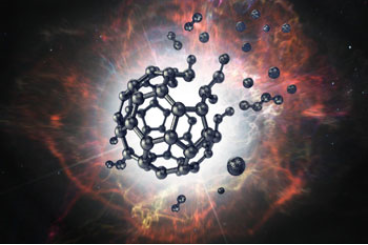For thousands of years, people have looked into the night sky and found stuff they didn't understand.
几千年来,人们在仰望星空的时候,发现了很多自己并不理解的事物。
That's kind of how astronomy happened.
这就是天文学产生发展的原因。

But not very many of those mysteries have lasted for a hundred years.
但并不是所有的谜题都需要100年那么久才能解决。
And even if they have, most of them aren't as simple as “what am I even looking at?”
即便需要很久,大多数问题也不是像“我现在看到的是什么?”这种简单的问题。
Then, there are the diffuse interstellar bands.
后来,我们发现了弥漫星际谱带。
These are patterns of light in space that don't match any known atom or molecule.
星际带是宇宙中的光带,不符合我们已知的任何原子或分子的特征。
There are hundreds of them, and we've been trying to figure out what they are for nearly a century.
星际带有上百个。近一个世纪以来,我们一直在竭力搞清它们究竟是什么。
After decades of work, scientists finally identified one of these bands in 2015, but even then, it's just downright bizarre:
经过几十年的研究,科学家最终在2015年弄清了其中一个星际带,但即便是那时候,我们对星际带的认知是非常奇怪的:
a cage-like carbon molecule containing sixty atoms.
像笼子一样的碳分子,里面有60个原子。
So what else is floating around out there? The diffuse interstellar bands, or DIBs, were first uncovered in 1919 by astronomer Mary Lea Heger.
那么,星级带里还有什么在飘动呢?弥漫星际谱带(DIB)第一次被人发现是在1919年,发现者是天文学家玛丽·利·赫格尔。
She was studying faraway stars by measuring their spectra, or the distribution of their light by wavelength.
她是通过测量光谱的方式来了解遥远恒星的,所谓光谱,就是光因波长不同而产生分布不同的现象。
Different molecules absorb and emit different types of light, so patterns in these readings typically tell astronomers what objects are made of.
不同的分子会吸收并释放不同类型的光,所以读数的图像可以让天文学家得知所观测物质的组成。
But this time, Heger noticed a pattern that had never been seen before, and it wasn't clear which molecules were the culprits.
但这一次,赫格尔注意到了一种光图像,这种图像是她此前未曾见过的。而且组成它的原子再明显不过了。
Their light absorption showed up as fuzzy gaps, or diffuse bands in spectra taken with early photographic plates, so these signals quickly picked up a nickname.
它们吸收的光辉产生模糊的沟,也就是光谱中的弥漫带,而光谱中的弥漫带是我们在照相底片上观察到的。所以这种信号很快就有了外号。
But it wasn't like astronomers had never found strange readings before.
但天文学家以前也发现过奇怪的读数。
In 1868, the observation of an unknown spectral band in the Sun's atmosphere had actually led to the discovery of helium.
1868年,天文学家在太阳的大气层上观测到了一种位置的光带,继而发现了氦。
It's science: New stuff comes up all the time.
所谓科学就是不断发现新事物嘛。
The weird part with DIBs is what happened next: nothing.
弥漫星际谱带的怪异指出在于接下来的事情:什么都没有。
Scientists were unable to find any matching atom or molecule here on Earth.
科学家在地球上无法发现任何可以匹配的原子或分子。
In fact, they still haven't, at least, for those specific signals.
实际上,他们至少还没有发现这种特定的信号。
Instead, over the next century, astronomers found nearly 500 more DIBs.
相反,未来一个世纪中,天文学家发现了近500多种弥漫星际谱带。
And until 2015, they hadn't explained a single one.
直到2015年为止,他们还没有解释其中任何一个星际带。
That year, a team of physicists were messing around with an exotic molecule called buckminsterfullerene.
而就在2015年,一组物理学家弄混了一种奇异的分子,名为巴克球。
Rather than repeating that word over and over, people usually just call them buckyballs, but they are not the same stuff as the popular magnetic toys.
由于巴克球的英文名字较长,所以大家不会反复重复这个名字,而是称它为巴基球,因为巴基球对应的英文名字更短。但巴基球跟风靡的磁铁玩具并不是同一种物质。
Buckyballs had been discovered during lab experiments in the 1980s designed to simulate the gas flowing out of carbon-rich stars.
巴基球上世纪80年代实验室里发现的,当时的试验是为了模拟从含碳量高的恒星中流出来的气体。
They're made of 60 linked carbon atoms, look remarkably similar to a soccer ball, and were cool enough to earn their discoverers the 1996 Nobel Prize in Chemistry.
巴基球由60个相互连接的碳原子组成,看起来很像足球。这种结构的发现也促成了1996年的诺贝尔化学奖。
The 2015 experiment cooled down a gas of buckyballs to nearly absolute zero and an ultralow pressure, essentially, the conditions of deep space.
2015年的实验将巴基球组成的气体进行降温,降到接近于绝对零度,并降低到场地气压,这样就符合深空的环境了。
And in that situation, the researchers found that buckyballs emit a spectrum of light that matched a set of diffuse interstellar bands discovered in 1994.
在这种环境下,科学家发现,巴基球会释放出一种光谱,而这种光谱跟1994年发现的弥漫星际谱带相吻合
Which was awesome! It meant we finally had at least one answer about these signals.
这个发现太棒了!因为它表明,我们终于有了关于这些信号的答案了,至少会有一个。
Researchers think these molecules may be formed in the atmosphere of a carbon-rich star.
科学家认为,这些分子可能在含碳量高的恒星大气层中形成的。
Then, they could be carried into space as part of the star's stellar wind, where they might survive for millions of years.
随后,这些分子以恒星风的形式被带入了太空中。在恒星风中,他们可能可以存活上百万年。
Whenever that gas floats between us and another star, it absorbs a bit of that star's light, and leaves behind its imprint in the form of a DIB.
一旦这种气体在地球和另一个恒星之间流动的时候,就会释放出一点这个恒星的光,并以弥漫星际谱带的形式留下印记。
So what about all the other diffuse bands? Well, many researchers are investigating molecules that contain carbon as potential culprits.
那其他弥漫谱带是怎么回事呢?这个嘛,很多科学家都在研究含碳的分子,把它们当成可能的目标。
Carbon is capable of forming four strong chemical bonds, which allows it to anchor the largest and most diverse collection of molecules in nature.
碳可以形成4种坚固的化学键,这样就可以固定住最大、最多样化的分子集。
And it's been a promising lead so far. Besides buckyballs, we now think some DIBs are probably created by other fullerenes, the category of large, cage-like carbon molecules that buckyballs belong to.
目前为止,这是走在最前面、也最有希望的方向了。除了巴基球之外,我们现在还认为,一些弥漫星际谱带很有可能是其他碳簇形成的。所谓碳簇,就是一种似笼的庞大碳分子组成的,而巴基球也是属于这种碳分子。
Complex molecules like these can come in a bunch of forms that are only slightly different from each other, but each of those tiny variations may be enough to create a new diffuse band.
这种复杂分子可以以多种形式呈现,彼此之间差别不大,但每一种细小的差异都有可能足以促使新的弥漫谱带形成。
Other DIBs might come from a different class of large carbon molecules: the polycyclic aromatic hydrocarbons.
其他弥漫星际谱带可能来自于不同类别的超大碳分子,也就是多环芳烃。
They're large, net-like structures of carbon and hydrogen that astronomers know are common throughout the universe.
多环芳烃体积庞大,结构似网,由碳氢组成。目前,科学家已经知道多环芳烃在宇宙中普遍存在。
But just focusing on carbon doesn't mean it will be easy for scientists to match more molecules with DIBs.
但专注于碳并不意味着科学家就能很容易地将更多分子跟弥漫星际谱带匹配在一起。
Unfortunately, it'll probably be slow going.
令人忧伤的是,这个过程的进展会很缓慢。
To get a spectrum, chemists and physicists have to recreate the conditions of deep space in the lab.
为了得到光谱,许多化学家和物理学家不得不重新在实验室里创造深空的环境。
That process is both really hard and a little different for every substance.
这个过程很艰难,而且每种物质的情况各不相同。
And I'm not a professional scientist, but that combination frankly doesn't sound that fun.
我不是专业的科学家,但这种包罗万象的环境听起来很苛刻。
To top it all off, there's a virtually unlimited number of potential molecules, which isn't the best situation when you're essentially doing guess-and-check.
最糟糕的是,潜在的分子数也数不尽,所以这并不是最好的环境,因为猜测加验证的工作量太大了。
For now, it seems likely that astronomers will keep finding new DIBs faster than lab scientists can explain them.
目前看起来很有可能的是,天文学家发现弥漫星际谱带的速度依然要比实验室科学家解释的速度要快。
There is, however, a silver lining: Each new, unexplainable band is a sign that an unknown, maybe even undiscovered molecule is floating out there in the cosmos.
不过,失望之中的希望是:每次有无法解释清楚的新带出现时,我们都会得到一个信号:一种未知的或者甚至尚未发现的分子正在宇宙间游荡。
And that's pretty cool. A little unnerving for researchers maybe, but cool.
这就很酷了。虽然对于研究人员来说是令人不安的消息,但真的很酷。
Thanks for watching this episode of SciShow Space!
感谢收看本期的《太空科学秀》!
If you'd like to learn about another mystery in the world of astronomy and planetary science, you can watch our episode about the Hypatia stone.
如果您想了解天文学和行星科学的其他奥秘,可以观看我们关于希帕提娅石的视频哦。











